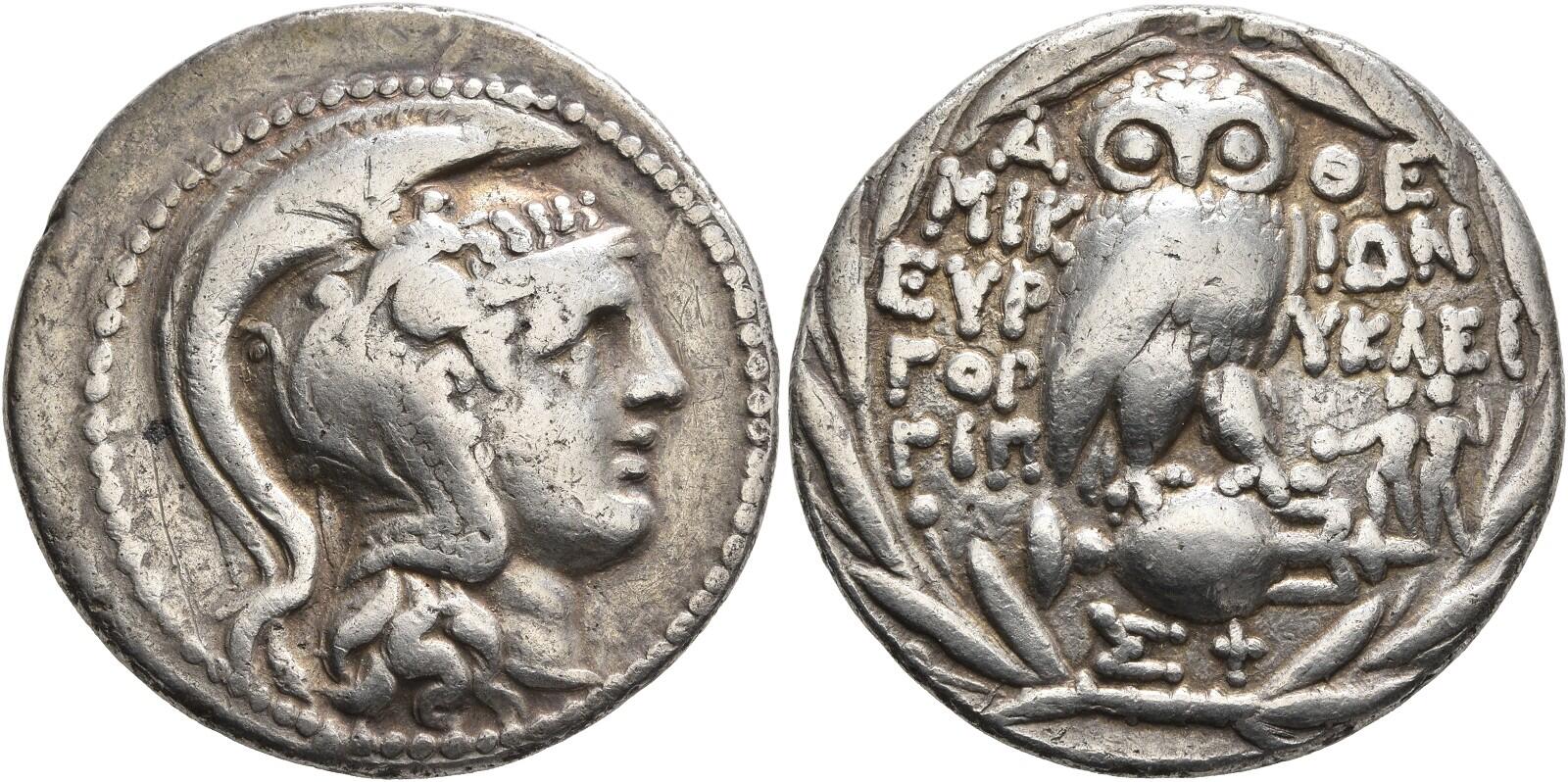110 BCE - 90 BCE | BAΣΙΛΕΩΣ AΛΕΞANΔΡΟΥ
Overstriking coin
Mesembria 849 Rudnik.jpg
Overstruck variety
Athens Mikion Euryklei.jpg
Description
| ObverseInscription or printing placed on the obverse.:
|
Head of Herakles right, wearing lion skin headdress.
|
ReverseInscription or printing placed on the reverse.:
|
BAΣΙΛΕΩΣ AΛΕΞANΔΡΟΥ (Greek) Zeus enthroned left, holding eagle and scepter. Under the throne, monogram (ΑY). In left field, Corinthian crested helmet and monogram (AX).
|
Mint and issuing power
| MintIdentifies the place of manufacture or issue of a numismatic object.:
|
Mesembria
|
Ancient regionAncient region.
|
Thrace
|
Modern countryModern country: Bulgaria
|
AuthorityIdentifies the issuing power. The authority can be "pretended" when the name or the portrait of X is on the coin but he/she was not the issuing power. It can also be "uncertain" when there is no mention of X on the coin but he/she was the issuing power according to the historical sources:
|
Alexander III the Great (Argead king, 336-323 BC)
|
Chronology
| FromIdentifies the initial date in a range assigned in a numismatic context. 110 BCE toIdentifies the final date in a range assigned in a numismatic context.. 90 BCE
|
hellenistic periodTime period of the numismatic object.
|
Physical description
MetalThe physical material (usually metal) from which an object is made.: Silver 
|
WeightWeight of the numismatic object (in grams). in grams: 15.7215.72 g <br />15,720 mg <br />
|
DenominationTerm indicating the value of a numismatic object. Examples: tetradrachm, chalkous, denarius.: tetradrachm 
|
AxisDescribes the directional relationship between the obverse and reverse of a numismatic object.: 1212 mm <br />1.2 cm <br />
|
| DiameterDescribes diameter of an object (in mm).: 3535 mm <br />3.5 cm <br />
|
StandardStandard.: Attic
|
References
| Coin referenceReference of the Coin:
|
Callataÿ - Prokopov 1994, p. 207
|
Coin series referenceReference to coin series study:
|
Price 19911Price 1991, n° 1097 (var.), Karayotov 19922Karayotov 1992, n° 343 (D68/R191), Karayotov 19943Karayotov 1994, p. 108, n° 718 (O77-R262 monogram 85), Callataÿ - Prokopov 19944Callataÿ - Prokopov 1994, p. 207, Callataÿ 1994b5Callataÿ 1994b, p. 326, D10/R1a, Callataÿ 1997a6Callataÿ 1997a, p. 96, D10/R1a, MacDonald 20097MacDonald 2009, p. 214, n° 18, Callataÿ 2021a8Callataÿ 2021a, p. 277, n° 19
|
Description
| ObverseInscription or printing placed on the obverse.:
|
Head of Athena, wearing Attic helmet.
|
ReverseInscription or printing placed on the reverse.:
|
Owl on amphora. In field, ΜΙΚΙΩΝ-ΕΥΡΥΚΛΕ.
|
Mint and issuing power
| MintIdentifies the place of manufacture or issue of a numismatic object. ᵖ:
|
Athens
|
Ancient regionAncient region. ᵖ
|
Attica
|
Modern countryModern country: Greece
|
AuthorityIdentifies the authority in whose name (explicitly or implicitly) a numismatic object was issued. ᵖ:
|
|
Chronology
| FromIdentifies the initial date in a range assigned in a numismatic context. 166 BCE toIdentifies the final date in a range assigned in a numismatic context.. 70 BCE
|
Hellenistic 323-30 BC  periodTime period of the numismatic object. periodTime period of the numismatic object.
|
Physical description
| DenominationTerm indicating the value of a numismatic object. Examples: tetradrachm, chalkous, denarius. ᵖ:
|
tetradrachm 
|
StandardStandard. ᵖ:
|
Attic
|
References
References
- ^ Price, Martin Jessop (1991), The Coinage in the Name of Alexander the Great and Philip Arrhidaeus: a British Museum Catalogue, 2 vol., Zürich-London, 637 p., 637 p., clix pl.
- ^ Karayotov, Ivan (1992), Mонетосеченето на Mесамбрия, Спектър - АЛ, Burgas, 130 p.
- ^ Karayotov, Ivan (1994), The coinage of Mesambria. vol. 1: silver and gold coins of Mesambria, Centre of Underwater Archaeology, Sozopol, 134 p. and 44 pl.
- ^ Callataÿ, François de - Prokopov, Ilya (1994), "A late alexander of Mesembria overstruck over Athens (Rudnik hoard)", Numismatic Circular, 102 (5), June 1994, p. 207.
- ^ Callataÿ, François de (1994), "Les derniers alexandres posthumes frappés à Odessos et Mésembria", in Settlement Life in Ancient Thrace. IIIrd International Symposium "Cabyle", 17-21 May 1993, Jambol (Bulgaria), p. 300-342
- ^ Callataÿ, François de (1997), L'histoire des guerres mithridatiques vue par les monnaies, Numismatica Lovaniensia 18, Louvain-la-Neuve, XIII + 481 p. et 54 pl.
- ^ Macdonald, David (2009), Overstruck Greek coins: studies in Greek chronology and monetary theory, Whitman Publishing, Atlanta.
- ^ Callataÿ, François de (2021), “On pattern and purpose of overstrikes of late Hellenistic tetradrachms in Thrace Macedonia”, in Ulrike Peter and Bernhard Weisser (eds.), Thrace. Local coinage and regional identity, Berlin Studies of the Ancient World 77, Berlin, Topoi, p. 263-289.
- ^ Thompson, Margaret (1961), The new style silver coinage of Athens, Numismatic Studies 10, New York, 2 vol.

